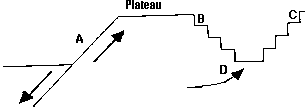Austrailia Earth's Oldest Continent
In July, 1996, the annual Does God Exist? summer seminar
was held in Australia. Each summer, we hold a seminar to train
people and motivate people to do the kind of work we do. Sometimes
the seminars are classroom-type programs, and other times they
are natural seminars in which participants travel to an area of
special interest and relevance to the question of God's existence.
In 1996, we worked with Queenslander Travel in Denver and Mr.
Mark Story in a program designed to expose participants to the
uniqueness of Australia. In addition to the trip with participants
who went from the United States, we conducted lectureships in
Blacktown (near Sydney), Cairns, and Brisbane. We also had a
number of Australian Christians who went with us on our special
trips into natural places.
Australia is a marvelous place to see a lot of unique things that
involve evolution and geology. In evolution, there is a principal
known as isolation that is used to explain why isolated animal
 populations are so unique. Australia has animals which are found
no place else in the world--the platypus, kangaroo, the echidna
(or spiny anteater), and the koala bear just to name a few. These
animals are radically different from the animals one sees in North
America or Europe. The mammals are marsupials using a very different
reproductive system and, in some cases like the platypus, having
physical properties unlike any other animal on the planet. No
American birds are seen in Australia--no hummingbirds,
cardinals, robins, bluejays, or tanagers. Instead, we see parrots,
cockateels, kookaburras, etc.
populations are so unique. Australia has animals which are found
no place else in the world--the platypus, kangaroo, the echidna
(or spiny anteater), and the koala bear just to name a few. These
animals are radically different from the animals one sees in North
America or Europe. The mammals are marsupials using a very different
reproductive system and, in some cases like the platypus, having
physical properties unlike any other animal on the planet. No
American birds are seen in Australia--no hummingbirds,
cardinals, robins, bluejays, or tanagers. Instead, we see parrots,
cockateels, kookaburras, etc.
Why does Australia have this unique collection of life? Evolutionists
tell us that Australia once had the same animal populations as
the Asian and European areas it was attached to. As geologic
forces separated Australia from these areas, their animal populations
could no longer interbreed. Genetic changes that took place in
the population would stay in that population. A crow might have
a mutation that would produce a white spot, and its offspring
would inherit this mutation. Soon all the crows would have the
white mark. In fact, there is a crow-like bird in Australia with
such a white mark in its plumage. The other ingredient evolutionists
postulate to explain the uniqueness of the animals in places like
Australia is natural selection.
Changes in animals that give them the ability to survive a predator,
disease, or climate change can be passed on to their offspring.
Undesirable characteristics in animals will cause these animals
to be killed, and these characteristics will cease to exist in
the animal population. Marsupial mammals like kangaroos, koala
bears, etc., are unable to compete with placental mammals. This
would mean that any marsupial on a land mass where placental mammals
existed would be likely to be eradicated. In fact, the only marsupial
in North America is the opossum. Rabbits, cats, dogs, water buffalo,
and sheep have caused massive problems of survival for Australia's
native animals and plants because the native animals cannot compete
with these introduced placental mammals.
This very brief and superficial explanation has been attempted
in order to demonstrate a point. Is there anything in this explanation
which is at odds with a literal understanding of the Bible? In
the Genesis account, the Hebrew word for kind is the word
"min." The Bible treats this word as a very broad term
covering a large variety of animals. The "flesh of fish"
in passages like I Corinthians 15:39 and Genesis 1:20 does not
refer to a goldfish, pike, perch, carp, bass, etc.-- but simply
to the group. The Bible also indicates to us that living things
can change. The serpent lost his legs at the curse, Jacob made
changes in the flocks of Laban, and many humans such as Esau clearly
had unique physical characteristics at birth. From a Christian
scientific view, it is God who created the major groups in such
a way that the early forms had a gene pool containing the potential
for surviving in all kinds of environments. If this had not been
done, every time there was a change in climate, everything would
have died. Australia is a classic example of the process because
the climate of Australia has gone through major changes, and plant
and animal life has had to adapt to all these changes.
The only real conflict that could exist between a scientist of
atheistic persuasion and one of Christian belief is the source
of the genetic information that allows adaptation to occur. The
Christian maintains that the genetic codes are a product of intelligent
design by God while the atheist maintains that blind, mechanistic
chance forces have produced totally by accident all kinds of gene
pools, including the desired ones. There have been numerous statistical
studies showing that such proposals are not possible,* but it
is the only alternative to God's Creation.
Not only is Australia of special interest because of its unique
animals, but it is also of special interest because of its age.
Earthquakes, volcanoes, and other products of active geologic
forces are a rarity in Australia. It is a very dry land with
very little modern modification by running water. As one goes
from Sydney to the west, you go through the wettest part of
the continent. Less than 100 miles west of Sydney you are in
the Blue Mountains. The area is easy to identify as it is a huge
plateau which has been eroded in a way that reminds you of the
Grand Canyon except that, due to the rainfall, it is rich in trees.
As you drive into the Blue Mountains, you go past faults that
can be seen in the road cuts along the highway as shown at A in
the diagram. The plateau is very easy to see with the layer at
B being the same rock in all ways as at C. Like the Grand Canyon,
the stair step arrangement of the layers is due to the different
degrees of hardness of the rocks making up the layers.

Each rock layer has a story to tell. Some are lavas indicating
volcanic activity and others are due to ocean environments. Near
the bottom of the canyon (D) is a coal seam containing
all the earmarks of an ancient swamp. Driving farther to the
West, one finds himself in the dry part of the continent.
For literally thousands of miles, there is sparse vegetation,
little water of any kind, and little evidence of man. Much of
the land is very flat and even the coastline shows evidence of
a long period of eroding agents. The heavy dissection of the
land and the lack of plant life allows an in-depth study of the
earth's early history. Some of the fossils of the oldest life
forms known to man are found in Australia in a group of rocks
known as the Ediocarian formation.
There have been those in the religious community who have tried
to view any understanding of the ancient history of the earth
as a threat to faith and yet, as you look at a coal seam at the
bottom of dozens of layers of rocks from all different kinds of
environments, you cannot deny that there is a history there.
The Bible does not deal with this history. All the Bible tells
us is that "God created the heaven and the earth." How
God did it or when God did it is not revealed to us.
What the Bible tells us is the history of man and, more particularly,
man's spiritual history.
Man's ability to read the physical history of the earth in the
rocks has led to the discovery of oil, gas, coal, metal, uranium,
and water resources throughout the earth. God created these resources
in such a way that we can find them, but only if we understand
how and where they were produced. Finding an oil deposit 16,000
feet underground would be an impossible dream unless you have
some idea of how it got there.
The rejection of the Bible and the denial of the existence of
God are strong beliefs in Australia. During our discussions with
nonbelieving Australians, it was obvious that they were really
rejecting the denominational creationists and their man-made theologies,
not God nor the Bible. Over and over, we heard comments about
the impossibility of believing that humans and dinosaurs lived
at the same time, that the earth was 6,000 years old, that God
created the cosmos full-grown with fossils buried in the ground,
etc. When we were able to get them to read Genesis and look at
what it really said and what it did not say, we were able to change
their whole approach to their relationship to God. Australia
has a lot to teach us--both in terms of what we can see in the
creation and also in terms of how important it is that we get
away from human traditions and theologies and just listen to what
God has to say and what He does not say.
--JNC
*Lester, Lane P. and Raymond G. Bohlin, The Natural Limits
to Biological Change,
1984.
Thaxton, Charles B., Walter L., Bradley, and Roger L. Olsen,
The Mystery of life's
Origin: Reassessing Current Theories, 1984.
Crick, Francis, Life Itself, Simon & Schuster. 1981.
Back to Contents Does God Exist?, Nov/Dec 1996
 populations are so unique. Australia has animals which are found
no place else in the world--the platypus, kangaroo, the echidna
(or spiny anteater), and the koala bear just to name a few. These
animals are radically different from the animals one sees in North
America or Europe. The mammals are marsupials using a very different
reproductive system and, in some cases like the platypus, having
physical properties unlike any other animal on the planet. No
American birds are seen in Australia--no hummingbirds,
cardinals, robins, bluejays, or tanagers. Instead, we see parrots,
cockateels, kookaburras, etc.
populations are so unique. Australia has animals which are found
no place else in the world--the platypus, kangaroo, the echidna
(or spiny anteater), and the koala bear just to name a few. These
animals are radically different from the animals one sees in North
America or Europe. The mammals are marsupials using a very different
reproductive system and, in some cases like the platypus, having
physical properties unlike any other animal on the planet. No
American birds are seen in Australia--no hummingbirds,
cardinals, robins, bluejays, or tanagers. Instead, we see parrots,
cockateels, kookaburras, etc.
